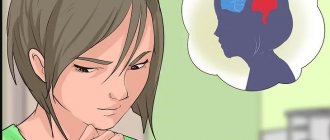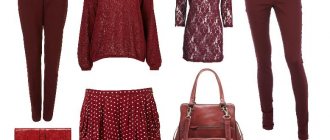Psychology of color
It is worth talking about the meaning of colors in psychology. The facts are well known how marketers use colors to increase store sales, how stylists select not only the clothes themselves, but also their shade for a person in order to attract the attention of others. These and other phenomena are studied by color psychology. The definition of colors in psychology and their influence on a person occurs primarily due to their effect on her mood and emotions. For example, when a person looks at dark blue, the number of beats of his heart per minute decreases and his breathing slows down. From this we can conclude: dark blue is a calming color, it gives peace and tranquility. Orange, on the contrary, increases blood pressure, speeds up the heartbeat, and gives a person some stimulation. Of course, colors act on the nervous system, on which all human life depends.
Asthenovegetative syndrome in children after infectious diseases
In the development of an infectious disease, four periods are usually distinguished: latent (incubation), prodromal, peak of the disease and outcome. The latent period lasts from the moment of exposure to the etiological factor until the appearance of the first clinical signs of the disease. During this period, the body’s defenses are mobilized, aimed at compensating for possible violations, at destroying pathogenic agents and removing them from the body. The prodromal period is the time interval from the first symptoms of the disease to its full manifestation. The period of pronounced manifestations of the disease is characterized by the complete development of the clinical picture. With various infectious diseases, the child’s nervous system may suffer, which is clinically manifested by neurotoxicosis syndrome. Neurotoxicosis is a nonspecific response of the child’s body to the effects of viral, bacterial or viral-bacterial flora, characterized by predominant damage to the central (CNS) and autonomic nervous system. The occurrence of asthenic syndrome is associated with the depletion of the functional capabilities of organs and systems as a result of the disease, especially the nervous system when it is overstrained, as well as due to autointoxication or exogenous toxicosis. This is the most common clinical manifestation of the convalescence period. Fatigue for a long time, which is not compensated by full recovery, causes overload syndrome, followed by a state of exhaustion. A subjectively felt feeling of fatigue is primarily a signal of overload of central regulatory systems, unsatisfactory state of the body's energy resources and autointoxication with metabolic products. Prolonged fatigue, leading to exhaustion, is essentially the result of stress on the body, causing dysfunction of the regulatory systems - autonomic, endocrine and immune. If stress factors act for a long time, a reaction of the body may develop, which may result in functional changes in the form of autonomic dysfunction [1, 6]. Autonomic dysfunction syndrome (AVS) includes the manifestation of all forms of disturbance of autonomic regulation. Along with somatic manifestations: dizziness, headaches, palpitations, shortness of breath, thirst, bulimia, vomiting after eating, intolerance to certain types of food, low-grade fever of unknown origin, skin rashes, etc., emotional disorders of varying severity in the form of anxiety are detected in patients with VDS , sleep disturbances, causeless crying, as well as behavioral disorders, in particular, impulsivity, increased motor activity and excitability, attention deficit, which is clinically defined as asthenovegetative or psychovegetative syndrome [Vein A. M., 1981].
The interest and complexity of the problem of asthenovegetative syndrome lies in the fact that it is complex: medical, psychological and pedagogical. However, all experts agree that such a condition exists, it must be diagnosed and corrected correctly.
Research objectives
This study is devoted to studying the dynamics of the state of the autonomic nervous system of children with asthenovegetative syndrome after infectious diseases, as well as assessing the effectiveness of the drug Tenoten for children in this pathology.
Tenoten for children contains ultra-low doses of antibodies to the brain-specific protein S-100, created using a special technology specifically for children, has a calming, normalizing effect on mood and behavior, as well as a pronounced vegetative stabilizing effect [3, 5].
Criteria for inclusion of patients in the study:
- Age from 3 to 8 years.
- Presence of symptoms of VDS.
- The severity of SVD is mild to moderate.
Criteria for excluding patients from the study:
- The presence of decompensated diseases or acute conditions that may affect the conduct of the study.
- Presence of organic brain diseases.
- Severe renal or liver failure.
- Hypersensitivity to any of the components of the drugs used in the study.
- Use of vegetotropic and nootropic drugs during the study period and in the last two weeks before the study.
- Participation in other clinical trials within four weeks before enrollment in this study.
Research material
50 children aged 3 to 8 years (4.54 ± 0.18 years) were observed at the 5th Children's Infectious Diseases Hospital of Saratov, of which 52% were boys, 48% were girls who had suffered complicated respiratory viral and other airborne infections. droplet infections, occurring mainly with neurotoxicosis syndrome, as well as frequently ill children undergoing dispensary observation in the clinic.
For the study using random sampling, children were divided into two groups. In the main group (30 people), children during the convalescence period, along with symptomatic vitamin therapy, received Tenoten for children, 1 tablet 3 times a day for 4 weeks in combination with standard therapy. The control group (20 people) included children who received standard vitamin therapy and symptomatic therapy with the exception of drugs with vegetotropic activity.
There were no significant differences in age and gender indicators between the main and control groups of children.
The selected groups of children also did not differ significantly in the range of diseases suffered, their severity, and the nature of complications. The spectrum of diseases included viral and viral-bacterial infections of the respiratory tract (etiologically confirmed forms of influenza and other respiratory viral infections, severe forms of bronchitis and pneumonia, etc.), acute otitis media, severe and complicated forms of infectious mononucleosis, visceral forms of chickenpox, occurring with neurotoxicosis and vesicular rashes on internal organs. Data on diseases are given in the table.
The diagnostic examination included a clinical assessment of the manifestations of autonomic dysfunction, a psychological examination, a neurological examination, and electrocardiography (ECG).
The state of the autonomic nervous system was determined by the initial autonomic tone, autonomic reactivity and autonomic support of activity. The initial autonomic tone, which characterizes the direction of functioning of the autonomic nervous system at rest, was assessed by analyzing subjective complaints and objective parameters. The severity of psychopathological manifestations was assessed: fatigue, anxiety, emotional instability, etc. (modified A.M. Vein questionnaire). The intrasystemic autonomic tone was determined by the Kerdo index and the intersystemic autonomic tone by the Hildebrant coefficient. To assess the vegetative support of activity, which mainly reflects the state of the autonomous regulatory system, a clinoorthostatic test (COT) was performed. The functional state of the cardiovascular system was also considered based on electrocardiography data.
The level of attention was assessed using the SNAP-IV scale, Schulte tables, according to the results of the modified Pierron–Ruserapo method. Identification of short-term and long-term memory disorders, which indirectly reflect the severity of asthenia, was carried out using the 10-word and pictogram technique.
To determine the state of the emotional sphere of the subjects (anxiety, depression), achromatic and Luscher color tests were used.
After completion of treatment, all children underwent a repeated comprehensive examination to assess the effectiveness of therapy. In addition, parents of children were asked to evaluate the results of treatment using a ten-point analogue-visual scale, where 0 is a very bad rating, 10 is very good.
Research results
Before the start of the study, in all the examined children (without significant differences in both groups), using the A. M. Vein questionnaire, moderately severe psychopathological disorders were determined, in the form of instability of the emotional background (84%), increased anxiety (34%), fatigue (38%). ), distractibility (86%), sleep disturbances (74%), memory loss, as well as various somatic manifestations in the form of recurrent headaches (52%), dizziness (24%), weather dependence (12%), decreased appetite (64% ), dyspeptic disorders in the form of nausea, vomiting, bloating (44%).
The Kerdo index made it possible to determine the presence of intrasystemic dystonia in children who had suffered severe infectious diseases; it averaged 32.89 ± 0.99 in both studied groups, which indicated the prevalence of sympathetic influences on the body at rest.
Intersystem autonomic tone, assessed using the Hildebrant coefficient (average values were 3.98 ± 0.03), was mainly eutonic in nature.
The COP, which determines the autonomic support of the autonomic regulatory system, along with the normal sympathicotonic variant of the COP, reflecting the stability of hemodynamics in orthostasis (14% of cases), also revealed pathological variants. The hypersympathicotonic variant of COP, characterized by a sharp increase in systolic blood pressure (SBP) and diastolic blood pressure (DBP) and heart rate (HR) and caused by excessive activation of the sympathetic-adrenal system, occurred in the majority of cases - in 58% of children. The asymptocotonic variant of COP, caused by insufficient connection of the sympathetic part of the autonomic nervous system, in which SBP and DBP do not change or fall, heart rate remains normal or compensatory increases, was found in 28% of children with SVD. The asthenosympathetic variant of COP with a drop in SBP and DBP and a sharp increase in heart rate in the first minutes of orthostasis, followed by a hypersympathicotonic reaction, was identified in 2% of cases.
The functional state of the cardiovascular system was also considered based on ECG data. Sinus tachycardia according to ECG data was detected in children in 70% of cases, apparently as a result of extracardiac influences (increased sympathetic innervation of the heart or weakened vagal innervation against the background of psycho-emotional arousal) in the absence of organic heart pathology, the so-called “nervous tachycardia”.
The main psychopathological manifestations of SVD were inattention, hyperactivity, and impulsivity. They were assessed using the SNAP-IV questionnaire (Swanson J., 1992). The rate of inattention in the two groups on this scale did not differ significantly and amounted to an average of 53.33% (norm (Swanson J., 1992) - 0.40–1.82), the average rate of hyperactivity - 1.96 ± 0.32 ( norm (Swanson J., 1992) - 0.27–1.59) and impulsivity 2.13 ± 0.37 (norm (Swanson J., 1992) - 0.26–1.52) (p < 0.05 — reliability of differences compared to age norms).
The severity of asthenia indirectly affects intellectual-mnestic indicators, in particular operative memory: the higher the child’s fatigue in the period after an infectious disease, the more the memorization process suffers. Memory assessment in children was carried out using the ten-word memorization technique. The following indicators were recorded: 1) the number of repetitions required to reproduce 10 words; 2) the number of words reproduced after 1 hour.
In most cases, the subjects of both groups (there were no significant differences in the indicators of children in the main group with the comparison group) required 3 or more repetitions to reproduce 10 words, which indicated a decrease in mechanical memorization. At the same time, the number of words reproduced an hour after the start of the study decreased significantly, which was a sign of impaired dynamic memory in children with autonomic dystonia.
A pictogram was used as a technique for studying indirect memorization. The following indicators were recorded: 1) the number of concepts reproduced; 2) dynamics of reproduced concepts after 1 hour.
An assessment of the results of the pictograms in general showed that in children with SVD dystonia, the depicted images often did not correspond to real objects, which subsequently made their interpretation difficult. Indicators for the criterion of adequacy (validity of the connection between the proposed concept and its pictogram) averaged about 50%.
A decrease in the criterion “recoverability of concepts after a delayed period” was also noted. Only 14% of subjects were able to fully reconstruct the entire list of proposed concepts. The decrease in the indicator was associated with the frequent use of the same pictograms to convey different concepts, errors and all kinds of inaccuracies, replacing words with their synonyms, abbreviating complex concepts, etc.
The Luscher Projective Color Choice Test was used to assess emotional disturbances. When testing, the following indicators were taken into account: “The first and last color in the color series”; “Coefficient of total deviation from the autogenic norm”; “Indicator of vegetative coefficient”; "Indicators of anxiety and tension."
Testing carried out using the Luscher method reflected a statistically significant deviation of the color range predominantly chosen by the subjects from the autogenous norm. At the same time, the value of the vegetative indicator did not have such significant differences compared to age norms. Average statistical indicators of anxiety and tension, determined using the Luscher test, also did not have significant deviations from standard indicators (p < 0.05 - significance of differences compared with age norms).
Thus, a clinical examination of children who had suffered infectious diseases revealed that they had varying degrees of severity of VDS manifestations. Of course, such psychovegetative disorders affected the period of convalescence, worsened the quality of life and required their adequate correction.
Tenoten for children with a calming and pronounced vegetative-stabilizing effect was used as an alternative drug to correct the manifestations of SVD (Lobov M. A., 2008). The main group of children (30 people) received Tenoten at a dose of 3 tablets/day for a course of 1 month in combination with standard vitamin therapy. A control group of children (20 people) received standard therapy using drugs that did not have psychotropic or vegetotropic activity. At the end of the course of treatment, repeated clinical studies were conducted.
Taking the drug Tenoten for children for a month provided a significant (in comparison with the control group) improvement in indicators of psycho-vegetative status and a decrease in the frequency of somatoneurological disorders in children taking Tenoten for children, while in the control group of children these indicators remained almost at the same level (Fig. 1, 2).
An improvement in autonomic tone was noted not only in its psycho-emotional (fatigue, anxiety, emotional instability, distractibility, sleep disturbance), but also in its somatoneurological (headaches, dizziness, loss of appetite, dyspeptic disorders) component. The obtained data are shown in Fig. 1.
The results of the CPC have changed qualitatively. In children taking Tenoten for children, there was a normalization of vegetative support indicators (sympathicotonic version of COP) from 15.33% of children at the beginning of therapy to 46.67% (p < 0.05); in the rest, there was a clear trend towards improvement. In the control group, the COP indicators remained almost at the same level. The data is shown in Fig. 3.
Positive dynamics were revealed in relation to pathopsychological manifestations. After a course of use of the drug, a decrease in the severity of mnestic and behavioral symptoms (inattention, hyperactivity, impulsivity) was noted on average in 85% of children. All indicators of the SNAP-IV scale in children of the main group after treatment with Tenoten decreased significantly (p < 0.05). Indicators of hyperactivity and inattention decreased to normal values, absolute indicators of impulsivity also decreased significantly in the observed group.
According to the psychometric study, significant positive changes were revealed in patients with SVD in the main group when conducting memory and attention tests in comparison with the control group. Testing data revealed a clear improvement in mechanical and dynamic memory in 30% of children (p < 0.05), as well as in mediated memory in tests with a pictogram - an increase in the adequacy index to 75% (p < 0.05).
A dynamic assessment of the results of the Luscher color test revealed a relative stabilization of the psycho-emotional state in children of the main group, which was reflected in the preferred color scheme and its approximation to the autogenic norm (according to the coefficient of total deviation from the autogenic norm - p < 0.05). In children of the control group, the determined indicators did not have statistically significant changes.
At the end of the study, parents assessed the results of treatment using a ten-point analogue-visual scale. On average, the success of treatment in the main group was rated at 7-8 points, in the control group - at 4-5 points.
conclusions
- The study showed that children who have had infectious diseases have varying degrees of severe symptoms of asthenovegetative syndrome (AVS) in the form of psychoemotional (fatigue, anxiety, emotional instability, distractibility, sleep disturbance) and somatoneurological (headaches, dizziness, decreased appetite, dyspepsia) disorders.
- Asthenovegetative disorders negatively affect the process of convalescence in children after severe infectious diseases, prolonging this period and worsening the quality of life of patients.
- The use of the drug Tenoten for children after infectious diseases at a dose of 1 tablet 3 times a day leads to normalization of autonomic tone and support, reduces the frequency of somatoneurological manifestations of autonomic dysfunction, which contributes to a faster completion of the recovery period.
- Tenoten for children eliminates manifestations of asthenia, stabilizes the psycho-emotional state of children: improves mood, calms, helps reduce irritability and moodiness, facilitates learning processes (memorization, concentration, perseverance).
- The drug Tenoten for children is safe in patients of senior preschool and primary school age. No side effects were noted during use of the drug.
- The proven calming, pronounced vegetotropic and antiasthenic effect of the drug Tenoten for children allows us to recommend it for use in children with various manifestations of vegetative-vascular dysfunction after infectious diseases.
For questions regarding literature, please contact the editor.
E. V. Mikhailova, Doctor of Medical Sciences, Professor T. Ilyicheva Saratov Regional Children's Infectious Diseases Clinical Hospital, Saratov State Medical University, Saratov
Visual perception of color
A person’s constant predilection for one shade or another is explained by his character. A person has always liked red, but suddenly he buys a gray item, regardless of the meaning of the colors of the clothes. In psychology, this phenomenon is explained simply: he’s used to red and wears it all the time, but he bought gray because at that moment his mood told him, a certain surge. It turns out that with the help of color, you can change your mood. Those who have had a bad look lately tend to look at darker shades. The choice happens intuitively. If the mood is high, then a person needs bright colors.
You and me
As psychology experts assure, the significance of the color red cannot be underestimated. It is important for building normal relationships between people. The traditional reading is love, desire, desire, feelings, passion. Red is called a symbol of the beginning of a new life. It is believed that the shade gives protection to women and protects people. Many interpret him as the patron saint of mothers and wives. For a long time, they resorted to red products to protect the husband from the evil thoughts of surrounding and envious outside women.
Luscher color test
Max Lüscher is a professor and psychologist from Switzerland. He devoted his scientific activity to studying the provisions of color diagnostics. It was he who came up with the test named after him, built on the basis of functional psychology. So what is the meaning of color in psychology according to Luscher? First of all, the professor emphasized that the structure of color, and therefore its meaning, remains unchanged. This means that whether a person likes dark blue or not, it still means “peace.” Luscher decided to consider the very attitude of people to the color scheme. And if each person sees it in his own way, then perhaps the meaning of colors in psychology also varies.
Test history
Created by Max Luscher in the middle of the 20th century, the test initially did not meet with approval among the scientific community, but over time his ideas gained popularity. The first version of the test was published in 1948, and a manual for it was published in 1970. Luscher also covered the basics of the color diagnostic method in his books “Personality Signals” and “The Four-Color Man.” The test was based on 4,500 color tones, which he selected independently.
Full and easy shortened versions of the Luscher test
"Clinical Luscher Color Test"
These are seven color tables, a cumbersome option that is used in cases where it is really needed. The colors of these seven tables are as follows:
- "grey";
- "8 colors";
- "4 primary colors";
- "blue";
- "green";
- "red";
- "yellow".
"Rapid" or "Abbreviated Luscher test"
A laconic and convenient test with eight rows of colors:
- gray(0);
- dark blue (1);
- blue-green (2);
- red-yellow (3);
- yellow-red (4);
- red-blue or purple (5);
- brown (6);
- black (7).
"Color selection method"
In 2010, Lyudmila Nikolaevna Sobchik proposed an adapted version of the shortened test - “Method of Color Choices” (MCV). This is how she commented on her work: “<...> the terminology and essence of interpretive maxims in the modified test have been significantly revised in accordance with the identified shortcomings of the original version of the method and taking into account the modern psychological thesaurus
».
Psychology of gray
Gray is a sign of neutrality, middle ground. The person who chooses it for himself does not take into account the meaning of colors in human psychology. She wants to stay away from everything outside. Such people prefer not to open up to others; they keep everything to themselves. This does not mean that they are tense or relaxed, they are simply in the middle, in neutral territory. This is the desire to isolate yourself from everything, to remain untouched.
Those people for whom gray comes last consider it very boring and monotonous. They prefer to enjoy life and enjoy bright colors. This is in some way connected with an irresistible desire to be constantly involved in some kind of activity.
Psychology of blue
Blue color has always symbolized peace and harmony. Scientists have proven that when a person looks at objects made in blue tones, he calms down. At this time, his body prepares for rest and relaxation. This shade carries a harmonious state and symbolizes unity with the world. The meaning of colors in psychology, especially blue, dark blue, indigo, cyan, contains associations with silence and peace.
Blue matches calm waters, a phlegmatic person, femininity, and tenderness. Many scientists believe that it has material completeness. Obese people most often give their preference to this particular shade. If during the test a person rejects the color blue, it means that he is running away from peace and trust, his need for this remains unsatisfied. This may indicate that he does not want to become attached to something and cannot afford to waste time on this, since, in his opinion, such an act entails giving up something very important. Relaxation can lead to depression, which many people try to stay away from. Usually they are constantly tense, and are in search of external stimuli, doing everything to ensure that a state of peace never occurs, because this can lead to a lifestyle devoid of meaning.
Everyday life and different ages
Observations have shown that red foods are beneficial for the human body. Their regular use allows you to cleanse the body of harmful compounds. Appetite improves, the likelihood of bowel dysfunction decreases. Foods that are naturally red are believed to be good for the liver. A diet containing an abundance of such food is recommended for the treatment of depression and helps to cope with melancholy. Such a diet is considered an additional measure for the treatment of nervous disorders; it is indicated for patients with smallpox.
Red foods are beneficial for children because most of these foods contain beneficial compounds that are indicated for anemia. Such products combat poor appetite and relieve apathy. If your child is underweight, including plenty of red foods in their diet will help them gain a few pounds.
Psychology of green
The effect of the color green is also considered an important component in the interpretation of the concept of “the meaning of colors.” In psychology, it is believed that people whose spiritual attachment is dissatisfied try to compensate with this particular paint. It symbolizes independence. Sympathy for her is often found among young people who want to quickly become independent. It is a symbol of constancy and perseverance, a certain degree of cruelty, firmness and perseverance. People who choose green are very wary of change. They strive to increase self-confidence in their skills and abilities through self-affirmation. They can gain sympathy from others, for example, due to their financial status.
This shade controls a person to some extent. A person may feel pride, superiority over others, and a desire to control other members of society. Green lovers tend to think a lot about health and how to increase their life expectancy. They defend their principles, sometimes suffering from the fact that they do not receive recognition from other people. As for those for whom green is in last place, we can say that they have lost the strength to fight. This may lead them to blame others for their mistakes. Those who reject the color green are people who have lost self-control and patience, resulting in impulsive behavior.
Psychology of red
People who want to experience sexual intoxication choose red or its shade of crimson. The significance in psychology shows that they are primarily looked at by individuals who crave exciting experiences and emotions. Shades of red symbolize vitality. They increase blood pressure and improve appetite. People who love red want to experience the fullness of life. Those who put it first are involved in sports and wrestling. This is the color of masculinity, aspiration, fire, spiritual strength, conquest. Also means sexual desire. People who have red in last place feel threatened by it because they lack vitality. They most often choose blue as a compensating color to enhance calmness. At the same time, attachment to him becomes painful due to failures in love.
Choosing the right color
Sometimes subjects misunderstand the test conditions and choose not the color that they liked, but the one that they think is preferred by the psychologist. Sometimes they choose colors that are associated with their social image: women choose red, and men choose blue, even if they actually dislike it.
In such a situation, it is impossible to obtain correct test results. The subject must understand that he should be guided only by his preferences. He should not try to choose colors that the psychologist will like, ask clarifying questions, or try in any other way to figure out the “correct” sequence of colors. In this test, it is the personal choice of sequence that matters, which reveals the personality traits of the subject.
Psychology of yellow
Often the rejection of blue causes a person to choose yellow. The meaning in psychology is associated with a burdening attachment that requires relief in order to eliminate depression. Unsatisfied emotionality forces a person to continually look for a way out of the situation. It is a search for satisfaction and harmony, an attempt to find the meaning of life and a place where you can use your capabilities to the maximum. Yellow color is the brightest, liveliest and lightest. Associated with stimulation. The pulse and breathing increase, just like with red.
The main advantage of yellow is its brightness and unconscious positivity. It indicates a person’s desire to free himself from heaviness, from something that oppresses him. People for whom this color comes first hope for happiness and expect it in all forms and manifestations. They want to achieve recognition and respect. Well, those who put yellow as last, as a rule, are disappointed in life, in hopes, in people. They stand face to face with emptiness. Due to the brightness inherent in yellow, it can be rejected due to overexcitation, as a result of which a person feels irritable, angry, distrustful of people, and is constantly in a bad mood.
Basic Rules
When taking the test, the subject must follow the rules so that the results obtained are as close as possible to his real experiences. The subject has the right:
- ask clarifying questions before starting the procedure;
- receive paper instructions that remain on the table while taking the test;
- refuse to undergo it if the technique causes him discomfort.
The subject is obliged:
- carefully follow the order of the test procedure;
- be as clear as possible when choosing your preferred colors;
- do not change the color choice after it has already been made.
The basic rule is that the subject must be in an adequate state, otherwise conducting a technique with the need to choose does not make sense.
Psychology of purple
People choosing a color scheme may not appreciate the meaning of lilac. In psychology, it indicates a person’s increased emotionality, as a result of which he can anticipate some actions or events. Purple is a mixture of red and blue, unbridled energy and calmness. Two opposing forces. The color violet is responsible for the love of magic and the desire to possess it. The meaning in psychology is explained, on the one hand, by a person’s dreams of sensual merging with a partner, and on the other hand, by isolation, because there are no prerequisites for this.
Situations and meanings
Considering the red color in the interior within the framework of psychology, we found that such a color has a positive and strong effect on a person in the morning. Surrounding yourself with scarlet objects makes it easier to cheer up. It is easier for a person to wake up, and the morning begins with a positive emotional mood. Starting a new day, a person is full of strength, cheerful and capable of new achievements. This is suitable for ambitious people. It won’t hurt to cheer yourself up with a red interior if you have a situation in which you need to show yourself cheerful. So, if negotiations are planned, the conclusion of a very significant deal, a color shake-up will not be superfluous.
It is known that red is an assistant in the erotic sphere. This color is associated with excitement. Thanks to interior items and the appropriate environment, it is easier for people to tune in to interaction. Traditionally, red is used in the interior of the rooms of young spouses. Such paints are chosen for dyeing underwear and bedding. The most luxurious is red natural silk. It is considered a classic and perhaps the most reliable means of arousal.
Psychology of brown
Scientists have long studied the psychology of color. The meaning of color in the clothes chosen by a person very well describes his essence. Brown color is a mixture of yellow and red with shading. All the unbridledness of red in it is muted, suppressed. It is put in first place by people who lack vitality. Everything around them is perceived passively. Brown symbolizes the sensory perception of the world and makes it clear how a person relates to physical sensations. He has an increased need for rest, for creating comfort and peace around himself. If brown is in last place or the color is rejected altogether, the person is seen as an individual trying to distinguish himself from the crowd. As a result, it can cause the attention of obsessive sexual people.
Curious to know
Color specialists and experts in the field of traditional medicine recommend using red stones to maintain your health. Bright scarlet varieties are considered especially useful. It is worth paying attention to scarlet varieties of coral. However, everything should be in moderation. By surrounding yourself excessively with such products, you can disrupt your own mental state. A person around whom there are too many red objects quarrels with others more often, he is more aggressive. It is believed that such persons tend to misunderstand the motives of others, and it is more difficult for them to build productive interactions with other people.
Psychology of black
Black expresses a highly controversial meaning of color. Meaning and psychology, combining into a single whole, give the idea that it is the darkest and is always associated with mourning and depression. Since for many this color symbolizes a certain border, it expresses “nothing, complete denial. Black gives a person the desire to defend himself and repress irritants. This is a refusal and a contradiction at the same time. A person for whom this color comes first is capable of giving up everything. Those who put black in last place do not want to endure hardships, place high demands on themselves and avoid danger.
Luscher identifies four color personality types
Characterizes these types as follows:
Blue - the need for deep affection.
Green – the need to defend one’s own position.
Red - the need for achievement, possession, leadership.
Yellow - the need for emotional involvement, vividness of experiences and communication.
The leading need determines the individual personality type of a person.
When assigning a personality to one or another “color type,” the decisive role is played by the assessment of the individual’s behavior.
At the same time, a person belonging to one of the four main personality types can behave in completely opposite ways. It depends on what role he is currently fulfilling.
When a person pursues a typical goal for himself, which is a kind of idol for him, the role he plays is called an “idol role.” And, conversely, what he does to protect himself from something, to avoid something - all this is his “protection role”.
For example, a person who implements the red type of behavior accepts every challenge thrown at him, because he wants to act strongly and successfully. This is his idol role. And he plays the defensive role when he feels that the demands placed on him are excessively high, when he defends himself from such demands, when he gets angry and annoyed, when he falls into impotent anger.
So, the types:
Blue
The main theme in their lives is spiritual affection and the need for mutual understanding. Blue strives to build harmonious relationships with the people around him.
Idol role (+ blue)
Need for peace, intense need for affection, sensitivity, sentimentality.
Role-protection (- blue)
Anxiety, impatience, dissatisfaction, loneliness, turning away from a partner, irritability.
The desire for satisfaction is at the core of the blue type idol role. Stupefaction and oblivion become his goal: either by stupefying the flesh with the help of riotous living, gluttony, alcoholism, the use of sedatives and sleeping pills, or by reducing spiritual claims (for example, reducing them to the level of “crossword” intelligence).
The role-protection of the blue type of behavior arises from the fear of emptiness (the absence of experiences) and of deprivation. Fear of lack of experience creates inner anxiety.
For the purpose of self-defense, “blue” people fence off their personal emotional sphere and block real and sincere emotional relationships.
Green
The main theme in the life of the green type is self-affirmation and self-development. A mature personality strives for self-expression and self-actualization.
Idol role (+ green)
The will to self-affirmation, tension of will, claim to significance.
Role-protection (- green)
Protection from restrictions, from loss of significance.
The desire for significance and vanity are at the core of the green idol role. Self-doubt is a completely unbearable state for him. Any means of increasing one’s own importance are used; academic titles, for example, will provide lifelong prestige and status, etc.
The defensive role is born out of fear of dependence and coercion.
Adequate behavior presupposes that a person is capable of both demanding and refusing. Anyone who has excessive or uncompromising claims, who wants everyone to admire and love him, ignores reality. When they don’t want to give up anything, then they can’t decide on anything. In this case, people begin to feel driven into a dead end.
Green is not only the most intense and the most stubborn, but also the most resistant to influence type of behavior.
Red
The main theme of harmonious development is the desire for success, to achieve set goals.
Idol role (+ red)
Purposefulness, an assertive desire for experiences.
Role-protection (- red)
Excessive demands, irritability.
The desire for excitement is at the core of the red type idol role. Fear of emptiness and boredom leads to a search for new stimuli. But since he needs more and more new experiences, he is inevitably forced to be constantly active. He strives for achievements in big and small, for the benefit of others or to the detriment of them.
Role-protection occurs due to fear of excess activity and overstimulation.
The one who hits the table with his fist or mutters something through his teeth, his excitement has reached the level of overirritation. Overirritation leads to depression if meeting important needs becomes impossible and you have to admit your own powerlessness. This gives rise to a depressive need for sleep or alcohol to intoxicate oneself and drown out one’s suffering.
Yellow
The main theme is development and creativity. With harmonious development, it is aimed at expanding “spiritual horizons.”
Idol role (+ yellow)
Escape from problems, illusory expectation of the future.
Role-protection (- yellow)
Tense anticipation, concern, anxiety.
The desire for freedom lies at the core of the idol role.
For example, many people spend two months every year on various trips or read newspapers for hours every day. In both of these cases, they are attracted not by an actual, not a true goal, but by the desire for the unknown, for change, the thirst for the new. Such curiosity is an escape from the present if it, the present, is experienced and perceived as unsatisfactory.
The defensive role stems from fear of loss. The surrounding world is a wide field of relationships, which, due to its constant change, constantly requires the individual to change his own position.
And any change in reality, the breadth of new possibilities, causes fear in yellow people. They feel lost, helpless in the face of reality.
Interpretation of color preferences
Do you like blue (+)
You can be classified as calm, balanced people who manage to achieve harmony in relationships with others. You also have the amazing ability to listen to your body's desires and recognize impending fatigue or emotional breakdown in time.
I don’t like blue or it’s annoying (-)
At the moment you are forced to give up the smooth flow of life, to live in a state of mobilizing all your strength. Perhaps this is connected with some important task or event, the result of which depends on your career or fate as a whole.
I like gray (+)
Gray means neutrality in all areas of life (“neither this nor that”). People who prefer gray work a lot and, accordingly, get very tired.
You don't like gray or it's annoying (-)
If you do not choose a gray shade under any circumstances, it means that you are striving with all your might for new experiences and do not want to let routine into your life.
Yellow (+)
Anyone who chooses this palette believes in a miracle.
He needs recognition of his abilities and respect from others. He hopes that sooner or later his life will change for the better and he will be able to enjoy happiness in all its forms.
Yellow (-)
If the yellow color is unpleasant to you, it means that you may have been completely disappointed in your hopes and now it is difficult for you to believe that miracles happen in the world.
This mood may be caused by some disappointment or failures that follow one after another.
Like black (+)
Means protest. Whoever chooses it can openly and secretly rebel against living conditions, work and his destiny in general. He protests against conventions, breaks stereotypes and rebels against injustice.
Black is annoying (-)
If you don't like the color black, then you have a difficult task ahead of you - learning to refuse people when necessary, and not being afraid to make the desired demands at work or in your personal life.
Red (+)
Red signifies the desire for fame, success and prestige. It is chosen by people who have strong strong-willed qualities, who want to reveal their potential, achieve influence and conquer everyone with their success.
Red (-)
If you feel a lack of vital energy and weak potential, then, most likely, you will prefer it last.
I like green (+)
You are a person for whom it is important to realize your potential, assert yourself and arouse the sympathy of others.
I don’t like green or it’s annoying (-)
If you choose the green card last, it means that at some point you could simply feel humiliated and defeated.
Perhaps your efforts to improve, for example, your work, were not crowned with recognition, so now it is easier for you to give in to principles than to persistently overcome obstacles.
Brown (+)
It is chosen by people who, more than anything else, want to avoid problems and conflicts in any area of life. They do not want to waste energy on solving complex tasks and dream of living in a cozy “shell”.
Brown (-)
You are driven by the desire to “break out of the crowd.”
Purple (+)
By choosing it, you seem to be communicating that all your thoughts and desires should come true. You can strive for “magical” relationships with others, believing that someday you will still be able to “bewitch” them with your charm and realize all your desires.











